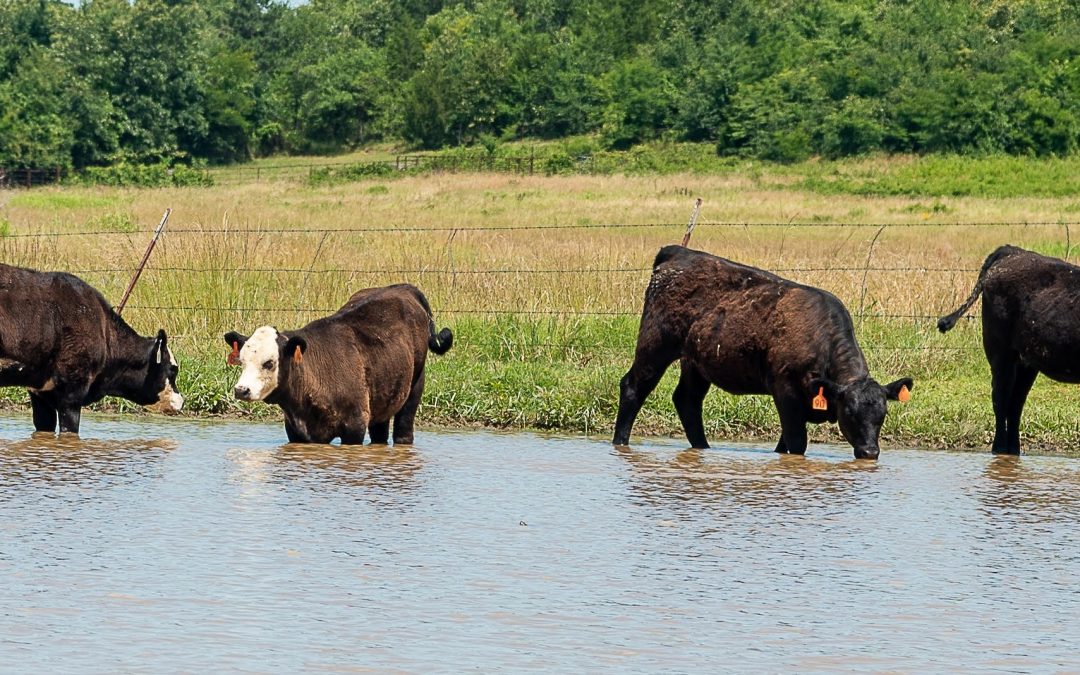By: Cody Welchons, Ph.D – Livestock Nutrition Center
Coming into the heat of the summer, it is important to think about how high temperatures and
humidity can affect cattle and to consider potential methods to mitigate heat stress. While cattle
in pens are more susceptible to heat stress, cattle on pasture can also be affected if there is not
sufficient shade for them to loaf in or open water sources for them to cool down in. Research at
the US Meat Animal Research Center (MARC) has identified four major risk factors for cattle
influencing susceptibility to heat stress.
- GENETICS– European lineage and dark colored cattle are the most susceptible compared to light
colored cattle and breeds that are tropically adapted. - HEALTH– Cattle that are currently sick or those that have experienced previous cases of
pneumonia are at elevated risk due to decreased lung capacity limiting their ability to dissipate
heat through respiration. - PRODUCTION STATUS– Heavier cattle are at greater risk than lighter cattle (i.e., close to
finished cattle in the feedyard vs stockers on grass). - PREVIOUS EXPOSURE TO HEAT STRESS CONDITIONS– Cattle that have been recently transferred from more temperate climates are likely to show a greater stress response than cattle that have had time
to acclimate to hotter conditions.
As cattle are largely unable to dissipate heat through sweating, they will primarily
regulate body temperature through increasing their respiration rate (panting) and decreasing feed
intake. Reduced feed intake will decrease heat generated by ruminal fermentation, which will help
the animal reduce overall heat loads. Thus, their ability to regulate body temperature is
influenced by air temperature, relative humidity, wind, thermal radiation, and diet. Once the heat
load of an animal surpasses its ability to dissipate that heat, stress occurs.
MANAGEMENT CONSIDERATIONS TO MITIGATE HEAT STRESS
- HANDLING – During periods of heat stress only work or move cattle early in the morning, and under extreme heat conditions refrain from handling cattle at all. Handling cattle causes an increase in body temperature to which there is a lag time before core temperature reaches its highest point. Therefore, under extreme heat conditions, even when it starts to cool off cattle should not be handled in the evening.
- WATER INTAKE – In the summer mature cows require 20-30 gallons of water per day, with this number increasing under extreme heat stress. Ensure that there is both adequate drinking space (3 linear inches per animal) and water pressure/capacity to supply needed water.
- SHADE – Providing 20-40 square feet of shade per animal (artificial or natural) can increase gains compared to non-shaded cattle both in confinement feeding and grazing scenarios.
- TIMING OF FEED DELIVERY – During periods of extreme heat, it may be beneficial to feed a greater amount of the daily feed delivery in the evening as cattle can then dissipate heat from their diet in the cooler part of the day compared to morning when they must dissipate heat production from eating during the hotter part of the day.
- FLY CONTROL – If cattle are suffering from heavy fly infestations, they will tend to gather in groups which reduces evaporative cooling due to decreased air flow.
References: US Meat Animal Research Center – About Cattle Heat Stress https://www.ars.usda.gov/plains-area/clay-center-ne/marc/docs/heat-stress/main/; Iowa State University – Heat Stress In Beef Cattle https://vetmed.iastate.edu/vdpam/about/production-animal-medicine/beef/bovine-disease-topics/heat-stress-beef-cattle; Noble Research Institute – When It’s Hot It’s Hot and When It’s Not, It’s Still Hot! https://www. noble.org/news/publications/ag-news-and-views/1999/august/when-its-hot-its-hot-and-when-its-not-its-still-hot/

Recent Comments